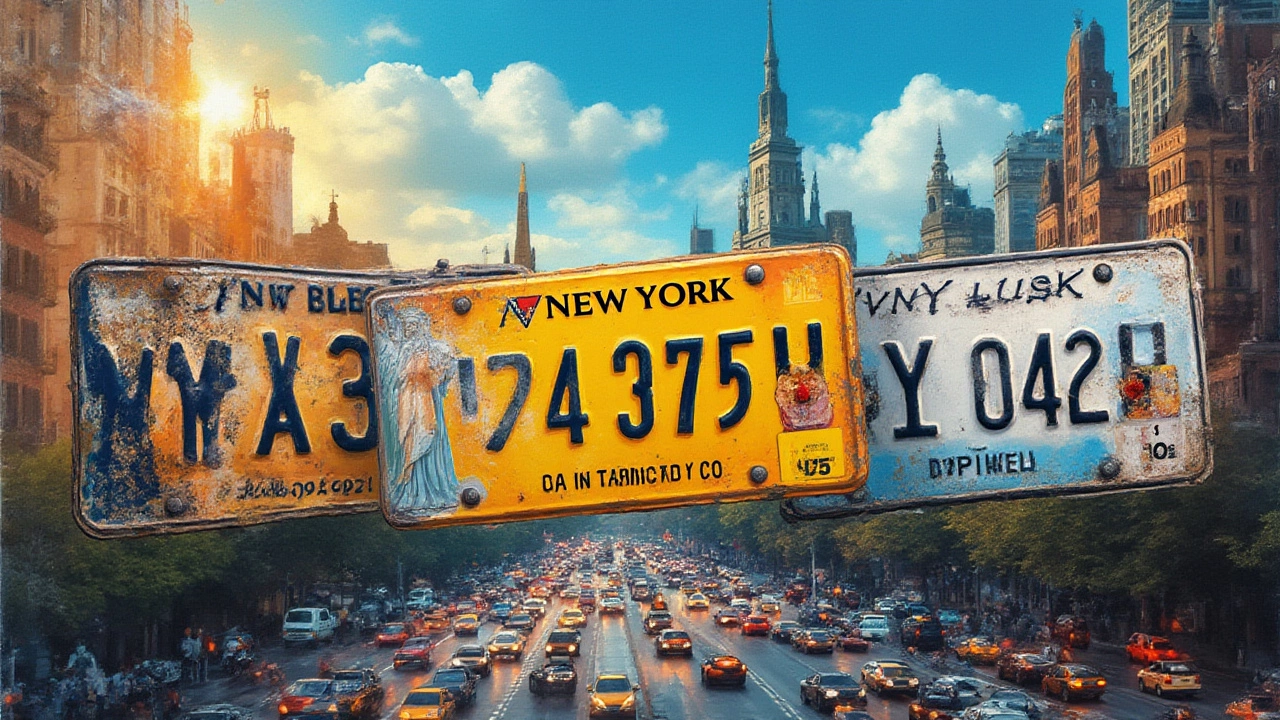Picture this: You’re stuck in New York City traffic. Every car, truck, and food delivery van sprinkles the streets with a flash of color from their license plates. But have you ever wondered—what color is the NY license plate now? It’s not just a piece of metal with numbers. For many, it’s a shortcut to knowing where a car’s from, what era it’s rolling in from, or even whether it’s got a backstory of having served in a particular agency or served up slices in Brooklyn for generations.
A Look at NY License Plate Colors: The Basics
Let’s cut to the chase. As of summer 2025, the standard-issue New York license plate is that familiar Empire Gold—a rich golden yellow backdrop with navy-blue letters and numbers. This combo hasn’t really budged since 2010, even after a lot of chatter about possible redesigns. If you see a car with yellow plates and blue characters, you’re looking at the state’s modern face. Catchy, bold, and hard to miss whether you’re merging on the Taconic Parkway or circling around the five boroughs looking for parking.
But this isn’t just about looks. Color matters. The NY DMV picked this gold-and-blue palette for visibility and maybe a touch of nostalgia—think back to the iconic yellow plates of the 1970s and ‘80s. Unlike other states, which switch up designs every few years (California, looking at you with that parade of white backgrounds), New York keeps it mostly consistent for decades. Besides the standard, you’ll notice a rainbow of specialty plates—commemorative, organization-based, and vanity designs—but about 90% of cars in the state still sport that Empire Gold look.
If you remember the “Empire State” plates from 2001 through 2010, those had a white background with a blue band up top, outlined with a red stripe and the New York skyline. That white-and-blue style finally gave way in 2010 to what we have today, with the goal of making the plates both stand out and easier to read for law enforcement and cameras.
Why the yellow? The DMV says the high-contrast combo actually saves time: it’s fast to spot in thick traffic, and digital plate readers—the ones that catch toll cheats and track Amber alerts—love the color split. There’s a dash of New York pride too, since the hue traces back to the plates first issued in 1966, which some locals call the "golden age" of New York driving (though the roads were anything but golden back then).
If you want to know whether a car’s plate is standard or specialty, check for three clues: background color, font, and the presence of any extra images. A splash of color or logo probably means the owner paid extra for a special plate. But Empire Gold is still king for the average New Yorker’s ride.
How NY License Plate Colors Became a Status Symbol
It’s wild how something as simple as color can trigger so much nostalgia—especially in New York. People still hunt for vintage NY plates, hoping to snag a blue-and-orange tag from the 1980s or the even earlier black-on-yellow classics from the ‘50s and ‘60s. Some car shows in upstate NY see collectors trading these relics for thousands of dollars, especially if the metal is straight and the paint isn’t faded.
Why are license plates such a big deal? Think about this: before the Empire Gold, there was the ‘Liberty’ plate (1986 to 2000) with its blue on white and a bright orange Statue of Liberty. ‘Liberty’ plates are like a collector’s badge of honor—if you see one today, chances are it’s on a classic car or someone’s pride-and-joy weekend cruiser. Then again, the plates from 1973 to 1986—solid gold background with deep blue numbers—are what many lifelong New Yorkers call “the real deal.”
Here’s a quick look at New York license plate colors and when they hit the scene:
| Years | Color Scheme | Nickname/Design |
|---|---|---|
| 1957–1962 | Black on gold | Original Gold |
| 1966–1973 | Gold on blue | Blue & Gold |
| 1973–1986 | Gold with blue | Empire Classic |
| 1986–2000 | White with blue and orange | Liberty Plate |
| 2001–2010 | White with blue, red trim | Empire State Plate |
| 2010–present | Empire gold with navy blue | Empire Gold |
If you’re ever at a car show, you’ll probably see someone arguing that the old plates “lasted longer” or “felt heavier.” And there’s some truth to that—older plates were often made of thicker steel or higher-quality aluminum. Nowadays, the plates are lighter (great for shipping in bulk statewide), but some say the golden color occasionally fades from sun, salt, and those brutal NY winters. Keep an eye out for that if you’re buying a used car; if the plate’s gone from gold to pale dull yellow, the car’s probably spent time parked on the street instead of garaged.
There’s actual status attached to the older color schemes; getting a low-digit or vintage plate in mint condition is street cred among collectors and car groups. Don’t be shocked to see someone in Brooklyn spending more on an original 1980s plate than on new rims.

Specialty Plates and Their Unique Colors
It’s not just gold and blue out there. New York rolls out a kaleidoscope of specialty license plates every year—each with its own unique color combo. Whether you’re an Army vet, a Yankees die-hard, or want to support the environment, there are literally hundreds of options, each with specific colors and sometimes little icons or state symbols.
- Veteran Plates: White background, red and blue text, plus a flag or service insignia. They stand out not just for color but for what they represent: service and sacrifice.
- College Plates: Want to show off your alma mater? NY issues plates in official school colors—think Cornell’s rich red or Syracuse’s trademark orange (so those stand out big time in traffic).
- Charity and Organization Plates: These come in everything from green-and-white for environmental causes to bright pink for breast cancer awareness.
- Vanity and Custom Plates: While these mostly keep the basic Empire Gold theme, you’re likely to see fun fonts, special characters, or custom backgrounds—even plates supporting the city’s iconic FDNY or NYPD.
The kicker? Special plates cost more: as of July 2025, most run about $25-60 extra for the first year, with a renewal fee tacked on annually. And rules are pretty strict: you need to prove your connection (alma mater ID, military papers) to get certain designs. But, some plates, like the environmental causes set, are open to anyone willing to pay up.
If you’re car-spotting in New York City, keep your eyes peeled for rare plates like the Governor’s black-and-white or the old NY World’s Fair models—a nod to the city’s deep history with design and culture.
Maintenance Tips, Fun Facts, and Recognizing Fakes
When it comes to NY license plates, it’s not just about color—but keeping that color sharp and your plate legal. Those long New York winters can be murder on any metal, especially when salt and grit start eating away at the paint. Rule number one: check your plates every spring. If they’re fading (that golden hue becomes lemony pale) or the blue numbers get chipped, the NY DMV actually expects you to order a new set. That’s $25 for a replacement plate, by the way, plus a possible $20 administration fee if you want to keep the same number sequence.
Don’t get sucked into eBay scams. Fake or replica NY plates pop up for “display purposes only,” but it’s illegal to mount a reproduction or altered plate. If the font looks suspicious or the color’s off, it doesn’t matter if you got it for cheap—it’s a risk. Police in Nassau County busted dozens of drivers in 2024 for so-called ‘ghost plates’ that ducked tolls and speed cameras. Honest tip: If you ever need a replacement, order straight from the NY DMV’s site or their official partners. Avoid online marketplaces unless you’re just decorating your garage.
Here’s a fun fact: In a 2022 survey by the American Association of Motor Vehicle Administrators, New York’s Empire Gold design landed in the top five for ease of recognition among law enforcement, outpacing states like Connecticut and Vermont. So, it’s not just drivers who notice the color—traffic officers and even parking meter crews rely on that strong color contrast daily.
Don’t forget: you have to keep BOTH front and rear plates affixed—no matter how much you’d like to show off that vintage grille. If one is missing, faded, or damaged, expect a citation. Some SUVs and trucks with plows lose their front plate over winter; don’t be that guy driving around with just the rear tag and hoping no cop notices.
Want to keep that plate shining gold? Wax it with a little car polish before winter. It’s not just for looks—wax can help stop road salt from eating away at the paint finish. And clean it every few weeks, especially after snow or a trip upstate.
Maybe you’re wondering, “Can I legally keep an old license plate color if I already own it?” State law says you have to use the newest design if you get a replacement or renew registration, unless you have a transferrable historic plate (which has its own strict set of rules and fees). So, if you see a car rocking pre-2010 blue-white Empire State plates, they’re either a diehard collector with paperwork or quietly breaking DMV rules.
Keep an eye on the NY DMV site for design updates. Every few years, the state floats rumors about new looks—back in 2020, there was actually an online vote for a fresh redesign, but most drivers stuck with familiar gold. State officials said at the time that “Empire Gold just feels like home.” Seems New Yorkers agree.
